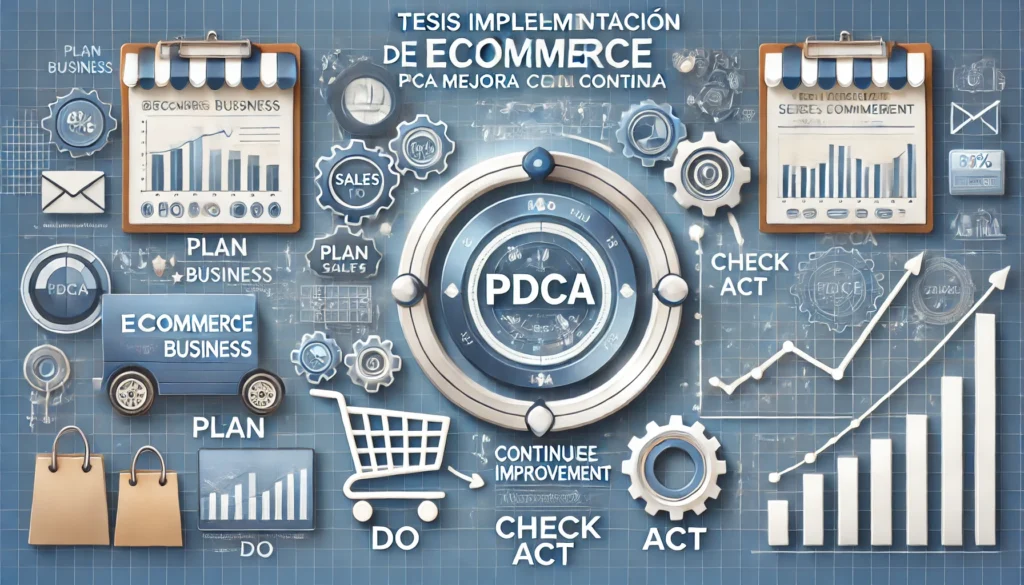Introduction: Understanding the Importance of PDCA in Ecommerce
The world of ecommerce is highly competitive, and businesses need a strong foundation to succeed. Tesis Implemetación DE Ecommerce PDCA is an approach that helps businesses grow sustainably by following a continuous improvement process. PDCA (Plan, Do, Check, Act) ensures that every decision in an ecommerce business is backed by data and refined through regular evaluation.
In this guide, we will explore how to implement the PDCA cycle in ecommerce, how it leads to better performance, and why it is crucial for long-term success. Whether you are a beginner or an experienced entrepreneur, this guide will provide actionable insights that can help you optimize and scale your ecommerce business.
What is PDCA? A Simple Explanation for Beginners
PDCA is a structured problem-solving approach that ensures continuous improvement. Here’s what it means in ecommerce:
- Plan – Identify issues, set goals, and create strategies.
- Do – Implement the plan and apply solutions.
- Check – Analyze performance metrics and results.
- Act – Make improvements based on findings and repeat the cycle.
PDCA is particularly useful in ecommerce because it helps businesses analyze customer behavior, optimize marketing strategies, and enhance user experience through iterative improvements.
Benefits of PDCA for Ecommerce

- Helps businesses make data-driven decisions.
- Ensures constant growth through improvement cycles.
- Reduces risks by testing and refining strategies.
- Enhances customer satisfaction by refining service quality.
The Role of PDCA in Ecommerce Implementation
Why is PDCA Important in Ecommerce?
Ecommerce businesses operate in a fast-changing environment. Implementing PDCA in ecommerce ensures that companies can adapt to changes, improve their strategies, and enhance customer satisfaction.
Challenges Faced by Ecommerce Businesses
- High competition and market saturation.
- Changing consumer behavior.
- Difficulty in maintaining website performance and conversions.
- Challenges in logistics, supply chain, and inventory management.
Applying the Ciclo PDCA en Ecommerce helps businesses address these challenges by allowing them to constantly refine their processes.
Step-by-Step Guide to Implementing PDCA in Ecommerce
Step 1: Plan – Setting the Foundation for Ecommerce Success
This is the most critical phase where businesses define their strategy.
Key Actions in the Planning Stage:
- Conduct market research to understand target customers.
- Set clear business goals and objectives.
- Choose the right ecommerce platform (Shopify, WooCommerce, Magento, etc.).
- Develop a content and marketing strategy.
- Set up logistics and inventory management systems.
Step 2: Do – Executing the Ecommerce Strategy
Once the plan is in place, it is time to take action.
Key Actions in the Doing Stage:
- Build and launch an SEO-optimized ecommerce website.
- Implement PPC, email, and social media marketing campaigns.
- Set up payment gateways and secure checkout options.
- Focus on customer service and engagement strategies.
Step 3: Check – Measuring and Analyzing Performance
Tracking performance helps businesses understand what’s working and what needs improvement.
Key Actions in the Checking Stage:
- Use Google Analytics, heatmaps, and A/B testing.
- Monitor conversion rates and bounce rates.
- Collect customer feedback and product reviews.
- Identify performance gaps in website speed, design, and user experience.
Step 4: Act – Implementing Improvements for Continuous Growth
In this phase, businesses refine their strategies based on performance data.
Key Actions in the Acting Stage:
- Adjust marketing strategies based on analytics.
- Optimize website navigation and checkout processes.
- Improve customer service and support systems.
- Automate ecommerce operations for better efficiency.
Advanced Strategies for Scaling an Ecommerce Business with PDCA

Leveraging PDCA for Ecommerce Growth
- Implement AI and automation for better customer engagement.
- Use data-driven decision-making for product recommendations.
- Expand internationally using PDCA insights.
- Continuously test and improve UX/UI for better conversions.
Case Studies: Real-World Examples of PDCA in Ecommerce
- Small Business Scaling: A local fashion brand increased sales by 50% using PDCA to refine its digital marketing strategy.
- Enterprise Success: A multinational retailer reduced cart abandonment rates by 30% by optimizing the checkout process with PDCA.
Conclusion: The Future of Ecommerce with PDCA
Businesses that apply PDCA in ecommerce gain a competitive edge by ensuring continuous improvement. Whether you are starting an ecommerce business or looking to scale, following the Tesis Implementación de Ecommerce PDCA approach will help you optimize processes, increase sales, and achieve long-term success.
FAQs
Qué es el Ciclo PDCA y cómo se aplica a un e-commerce?
El Ciclo PDCA (Plan, Do, Check, Act) es un método de mejora continua que ayuda a optimizar procesos en un e-commerce. Se implementa en cuatro fases:
- Plan (Planificar): Definir la estrategia, el público objetivo, la plataforma, los productos y la logística.
- Do (Hacer): Implementar el e-commerce, configurar pagos, SEO, campañas de marketing y procesos de venta.
- Check (Verificar): Medir los resultados con KPIs como tráfico, conversión y satisfacción del cliente.
- Act (Actuar): Implementar mejoras basadas en los datos analizados y repetir el ciclo.
Cuáles son los beneficios de usar PDCA en un e-commerce?
- Identificación rápida de problemas y mejoras.
- Optimización continua de la experiencia del cliente.
- Adaptación ágil a cambios en el mercado.
- Reducción de costos y aumento de eficiencia.
- Mayor conversión y fidelización de clientes.
Cuánto tiempo toma implementar un e-commerce con PDCA?
Depende de la complejidad del proyecto, pero generalmente:
- Fase de Planificación: 2-4 semanas.
- Fase de Implementación: 4-8 semanas.
- Fase de Evaluación: Continuo (cada semana/mes).
- Fase de Mejora: Iterativa, cada 1-3 meses.
Qué plataformas de e-commerce son compatibles con PDCA?
Las plataformas más utilizadas son:
- Shopify: Fácil de usar y optimizada para la mejora continua.
- WooCommerce: Flexible y escalable con análisis integrados.
- Magento: Potente y personalizable para negocios grandes.
- PrestaShop: Opciones avanzadas de personalización y gestión.
- Tiendanube: Ideal para Latinoamérica con integración sencilla.
Qué herramientas ayudan a medir el rendimiento en la fase de Check?
- Google Analytics: Para tráfico y conversión.
- Google Search Console: Para SEO y rendimiento en buscadores.
- Hotjar: Para mapas de calor y análisis de experiencia del usuario.
- Klaviyo / Mailchimp: Para análisis de email marketing.
- Meta Business Suite: Para seguimiento de campañas en redes sociales.
Cómo puedo mejorar la tasa de conversión de mi e-commerce con PDCA?
- Revisar datos de tráfico y embudo de conversión (Check).
- Hacer pruebas A/B en diseño, precios y llamadas a la acción (Act).
- Optimizar fichas de productos con mejores imágenes y descripciones (Plan).
- Implementar estrategias de retargeting y marketing automatizado (Do).
Cómo optimizar el servicio al cliente con PDCA?
- Medir tiempo de respuesta y satisfacción (Check).
- Mejorar chatbots y atención personalizada (Act).
- Implementar nuevos canales de atención como WhatsApp o redes sociales (Plan).
- Automatizar respuestas y seguimiento post-compra (Do).
Cómo hacer que mi e-commerce sea más rentable con PDCA?
- Evaluar costos de adquisición y margen de ganancia (Check).
- Optimizar campañas publicitarias y eliminar gastos innecesarios (Act).
- Diseñar estrategias de upselling y cross-selling (Plan).
- Implementar descuentos, programas de lealtad y ventas recurrentes (Do).
Cuáles son los errores comunes al implementar PDCA en un e-commerce?
- No definir métricas claras en la fase de planificación.
- Implementar cambios sin pruebas o datos previos.
- No realizar revisiones constantes en la fase de Check.
- No actuar sobre los hallazgos y seguir con procesos ineficientes.
Cada cuánto tiempo debo repetir el ciclo PDCA en mi e-commerce?
Idealmente, el PDCA debe aplicarse de forma continua. Se recomienda hacer revisiones cada:
- Semana: Para optimización de campañas y experiencia del usuario.
- Mes: Para evaluación de KPIs clave y mejoras estratégicas.
- Trimestre: Para realizar cambios estructurales y expansiones.








